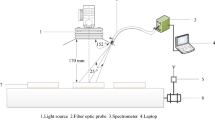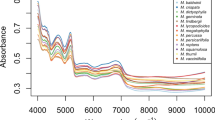Abstract
The feasibility of applying the infrared spectroscopy for the geographical origin traceability of lentils from two different countries (Italy and Canada) was investigated. In particular, lentil samples were analyzed by Fourier transform near- and mid-infrared (FT-NIR and FT-MIR) spectroscopy and then discriminated by applying supervised models, i.e., linear discriminant analysis (LDA) and partial least squares discriminant analysis (PLS-DA). To avoid LDA overfitting, two variable strategies were adopted, i.e., a variable reduction by principal component analysis and a variable compression by wavelet packet transform algorithm. FT-MIR models were more discriminating compared to FT-NIR ones with prediction abilities ranging from 98 to 100% and from 91 to 100% for cross- and external validation, respectively. The combination of the FT-MIR and FT-NIR data did not improve the model performances. These findings demonstrated the suitability of the FT-MIR spectroscopy, in combination with supervised pattern recognition techniques, to successfully classify lentils according to their geographical origin.


Similar content being viewed by others
References
Ballabio D, Consonni V (2013) Classification tools in chemistry. Part 1: linear models. PLS-DA. Anal Methods-UK 5:3790–3798
Berrueta LA, Alonso-Salces RM, Héberger K (2007) Supervised pattern recognition in food analysis. J Chromatogr A 1158:196–214
Borràs E, Ferré J, Boqué R, Mestres M, Aceña L, Busto O (2015) Data fusion methodologies for food and beverage authentication and quality assessment – a review. Anal Chim Acta 891:1–14
Casale M, Casolino C, Oliveri P, Forina M (2010) The potential of coupling information using three analytical techniques for identifying the geographical origin of Liguria extra virgin olive oil. Food Chem 118:163–170
Chandra S, Chapman J, Power A, Roberts J, Cozzolino D (2017) Origin and regionality of wines—the role of molecular spectroscopy. Food Anal Methods 10:3947–3955
Chiesa L, Panseri S, Bonacci S, Procopio A, Zecconi A, Arioli F, Cuevas FJ, Moreno-Rojas JM (2016) Authentication of Italian PDO lard using NIR spectroscopy, volatile profile and fatty acid composition combined with chemometrics. Food Chem 212:296–304
Cozzolino D (2014) An overview of the use of infrared spectroscopy and chemometrics in authenticity and traceability of cereals. Food Res Int 60:262–265
Cuevas FJ, Moreno-Rojas JM, Arroyo F, Daza A, Ruiz-Moreno MJ (2016) Effect of management (organic vs conventional) on volatile profiles of six plum cultivars (Prunus salicina Lindl.). A chemometric approach for varietal classification and determination of potential markers. Food Chem 199:479–484
de Almeida Costa GE, da Silva Queiroz-Monici K, Reis SMPM, de Oliveira AC (2006) Chemical composition, dietary fibre and resistant starch contents of raw and cooked pea, common bean, chickpea and lentil legumes. Food Chem 94:327–330
DM (Decreto Ministeriale) n.350/1999. Regolamento recante norme per l’individuazione dei prodotti tradizionali di cui all’articolo 8, comma 1, del decreto legislativo 30 aprile 1998, n. 173. (GU Serie Generale n.240 del 12-10-1999). URL http://www.gazzettaufficiale.it/atto/serie_generale/caricaDettaglioAtto/originario?atto.dataPubblicazioneGazzetta=1999-10-12&atto.codiceRedazionale=099G0423&elenco30giorni=false. Accessed 10.10.2018
Dupuy N, Galtier O, Ollivier D, Vanloot P, Artaud J (2010) Comparison between NIR, MIR, concatenated NIR and MIR analysis and hierarchical PLS model. Application to virgin olive oil analysis. Anal Chim Acta 666:23–31
EU Regulation (European Union Regulation) No 1151/2012 of the European Parliament and of the Council of 21 November 2012 on quality schemes for agricultural products and foodstuffs. URL http://data.europa.eu/eli/reg/2012/1151/oj. Accessed 10.10.2018
FAOSTAT (Food and Agriculture Organization of the United Nations). Crops data, 2016. URL http://www.fao.org/faostat/en/#data/QC. Accessed 17.07.2018
Forina M, Lanteri S, Armanino C, Casolino C, Casale M., Oliveri P (2010) V-PARVUS 2010. Dip. Chimica e Tecnologie Farmaceutiche ed Alimentari, University of Genova. URL http://www.difar.unige.it/index.php/download-parvus/category/3-parvus.html. Accessed 17.07.2018
Holse M, Larsen FH, Hansen Å, Engelsen SB (2011) Characterization of marama bean (Tylosema esculentum) by comparative spectroscopy: NMR, FT-Raman, FT-IR and NIR. Food Res Int 44:373–384
ISTAT (Istituto Nazionale di Statistica). Tavola C04 ̶ Superficie (ettari) e produzione (quintali): pisello da granella, cece, lenticchia, 2016. URL http://agri.istat.it/sag_is_pdwout/jsp/dawinci.jsp?q=plC040000010000012000&an=2016&ig=1&ct=245&id=15A|18A|26A. Accessed 17.07.2018
Kouvoutsakis G, Mitsi C, Tarantilis PA, Polissiou MG, Pappas CS (2014) Geographical differentiation of dried lentil seed (Lens culinaris) samples using diffuse reflectance Fourier transform infrared spectroscopy (DRIFTS) and discriminant analysis. Food Chem 145:1011–1014
Latorre CH, Crecente RP, Martín SG, García JB (2013) A fast chemometric procedure based on NIR data for authentication of honey with protected geographical indication. Food Chem 141:3559–3565
Leme LM, Montenegro HR, dos Santos LDR, Sereia MJ, Valderrama P, Março PH (2018) Relation between near-infrared spectroscopy and physicochemical parameters for discrimination of honey samples from Jatai weyrauchi and Jatai angustula bees. Food Anal Methods 11:1944–1950
Li Y, Zhang JY, Wang YZ (2018) FT-MIR and NIR spectral data fusion: a synergetic strategy for the geographical traceability of Panax notoginseng. Bio Anal Chem 410:91–103
Longobardi F, Casiello G, Cortese M, Perini M, Camin F, Catucci L, Agostiano A (2015) Discrimination of geographical origin of lentils (Lens culinaris Medik.) using isotope ratio mass spectrometry combined with chemometrics. Food Chem 188:343–349
Longobardi F, Innamorato V, Di Gioia A, Ventrella A, Lippolis V, Logrieco AF, Catucci L, Agostiano A (2017) Geographical origin discrimination of lentils (Lens culinaris Medik.) using 1H NMR fingerprinting and multivariate statistical analyses. Food Chem 237:743–748
Massart DL, Vandeginste BGM, Buydens LMC, De Jong S, Lewi PJ, Smeyers-Verbeke J (1997) Principal components. In: Vandeginste BGM, Rutan SC (eds) Handbook of chemometrics and qualimetrics: part. A. Elsevier, Amsterdam, pp 519–556
Medina J, Caro Rodríguez D, Arana VA, Bernal A, Esseiva P, Wist J (2017) Comparison of attenuated total reflectance mid-infrared, near infrared, and 1H-nuclear magnetic resonance spectroscopies for the determination of coffee’s geographical origin. Int J Anal Chem 2017:Article ID 7210463, 8 pages. https://doi.org/10.1155/2017/7210463
Meng W, Xu X, Cheng KK, Xu J, Shen G, Wu Z, Dong J (2017) Geographical origin discrimination of oolong tea (TieGuanYin, Camellia sinensis (L.) O. Kuntze) using proton nuclear magnetic resonance spectroscopy and near-infrared spectroscopy. Food Anal Methods 10:3508–3522
Min MJ, Shin HJ (2015) Chemical composition and nutritional characteristics of lentils (Lens culinaris), and their application in the food industry: a review. Korean J Food Sci Technol 47:273–280
Moscetti R, Radicetti E, Monarca D, Cecchini M, Massantini R (2015) Near infrared spectroscopy is suitable for the classification of hazelnuts according to Protected Designation of Origin. J Sci Food Agric 95:2619–2625
Ottavian M, Facco P, Barolo M, Berzaghi P, Segato S, Novelli E, Balzan S (2012) Near-infrared spectroscopy to assist authentication and labeling of Asiago d’allevo cheese. J Food Eng 113:289–298
Plans M, Simó J, Casañas F, Sabaté J, Rodriguez-Saona L (2013) Characterization of common beans (Phaseolus vulgaris L.) by infrared spectroscopy: comparison of MIR, FT-NIR and dispersive NIR using portable and benchtop instruments. Food Res Int 54:1643–1651
Rinnan Å, van den Berg F, Engelsen SB (2009) Review of the most common pre-processing techniques for near-infrared spectra. TrAC-Trends Anal Chem 28:1201–1222
Rodriguez-Saona LE, Allendorf ME (2011) Use of FTIR for rapid authentication and detection of adulteration of food. Annu Rev Food Sci Technol 2:467–483
Rodriguez-Saona LE, Giusti MM, Shotts M (2016) Advances in infrared spectroscopy for food authenticity testing. In: Downey G (ed) Advances in food authenticity testing. Elsevier, Woodhead Publishing, Duxford, pp 71–116
Scampicchio M, Eisenstecken D, De Benedictis L, Capici C, Ballabio D, Mimmo T, Robatscher P, Kerschbaumer L, Oberhuber M, Kaser A, Huck CW, Cesco S (2016) Multi-method approach to trace the geographical origin of Alpine milk: a case study of Tyrol Region. Food Anal Methods 9:1262–1273
Slow Food Foundation for Biodiversity (n.d.) International Presidia: Legumes. URL https://www.fondazioneslowfood.com/en/slow-food-presidia/?fwp_settori_presidi=legumes. Accessed 10.10.2018
Sun D (2009) Infrared spectroscopy for food quality analysis and control. Academic Press, San Diego
Takruri HR, Issa AY (2013) Role of lentils (Lens culinaris L.) in human health and nutrition: a review. Med J Nutrition Metab 6:3–16
Teixeira dos Santos CA, Pascoa RN, Sarraguca MC, Porto PA, Cerdeira AL, González-Sáiz JM, Pizarro C, Lopes JA (2017) Merging vibrational spectroscopic data for wine classification according to the geographic origin. Food Res Int 102:504–510
Uríčková V, Sádecká J (2015) Determination of geographical origin of alcoholic beverages using ultraviolet, visible and infrared spectroscopy: a review. Spectrochim Acta A Mol Biomol Spectrosc 148:131–137
USDA (United States Department of Agriculture). National Nutrient Database for Standard Reference, Release Legacy April, 2018, Basic Report 16069, Lentils, raw, 2018. URL https://ndb.nal.usda.gov/ndb/foods/show/303688?manu=&fgcd=&ds=&q=Lentils,%20raw. Accessed 17.07.2018
Vandeginste BGM, Massart DL, Buydens LMC, De Jong S, Lewi PJ, Smeyers-Verbeke J (1998) Supervised pattern recognition. In: Vandeginste BGM, Rutan SC (eds) Handbook of chemometrics and qualimetrics: part. B. Elsevier, Amsterdam, pp 207–241
Walczak B, Massart DL (1997) Wavelet packet transform applied to a set of signals: a new approach to the best-basis selection. Chemometr Intell Lab 38:39–50
Wang N, Daun JK (2006) Effects of variety and crude protein content on nutrients and anti-nutrients in lentils (Lens culinaris). Food Chem 95:493–502
Xu L, Fu HY, Yang TM, Li HD, Cai CB, Chen LJ, She YB (2016) Enhanced specificity for detection of frauds by fusion of multi-class and one-class partial least squares discriminant analysis: geographical origins of Chinese shiitake mushroom. Food Anal Methods 9:451–458
Yahui L, Xiaobo Z, Tingting S, Jiyong S, Jiewen Z, Holmes M (2017) Determination of geographical origin and anthocyanin content of black goji berry (Lycium ruthenicum Murr.) using near-infrared spectroscopy and chemometrics. Food Anal Methods 10:1034–1044
Zhang BL, Emeriau L, Martin GJ (1991) Comparison of the isotopic behaviour of Leguminosae constituents. Characterization of lentils. Sci Aliments 11:291–304
Zhao H, Guo B, Wei Y, Zhang B (2013) Near infrared reflectance spectroscopy for determination of the geographical origin of wheat. Food Chem 138:1902–1907
Acknowledgements
The authors would like to thank Salvatore Cervellieri for his technical support. The authors are grateful to Dr. Christoph von Holst (Joint Research Centre, European Commission, Belgium) for helpful suggestions in the preparation of the manuscript.
Author information
Authors and Affiliations
Corresponding author
Ethics declarations
Conflict of Interest
Valentina Innamorato declares that she has no conflict of interest. Francesco Longobardi declares that he has no conflict of interest. Vincenzo Lippolis declares that he has no conflict of interest. Marina Cortese declares that she has no conflict of interest. Antonio F. Logrieco declares that he has no conflict of interest. Lucia Catucci declares that she has no conflict of interest. Angela Agostiano declares that she has no conflict of interest. Annalisa De Girolamo declares that she has no conflict of interest.
Ethical Approval
This article does not contain any studies involving human participants or animals performed by any of the authors.
Informed Consent
Not applicable as this study does not include any human participants.
Additional information
Publisher’s Note
Springer Nature remains neutral with regard to jurisdictional claims in published maps and institutional affiliations.
Rights and permissions
About this article
Cite this article
Innamorato, V., Longobardi, F., Lippolis, V. et al. Tracing the Geographical Origin of Lentils (Lens culinaris Medik.) by Infrared Spectroscopy and Chemometrics. Food Anal. Methods 12, 773–779 (2019). https://doi.org/10.1007/s12161-018-1406-8
Received:
Accepted:
Published:
Issue Date:
DOI: https://doi.org/10.1007/s12161-018-1406-8




